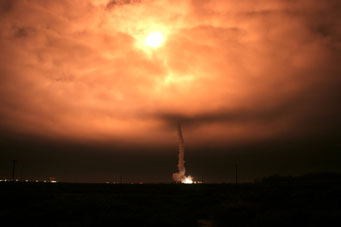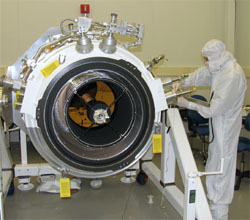Imagine what astronomers' nightlife would be like if we had infrared-sensing eyesight unfettered by Earth's atmosphere. Every clump of interstellar gas and dust would glow like a cheesy used-car lot, brown dwarfs would pepper the sky, and extremely distant galaxies would emerge into view like specters from the universe of 10 billion years ago.

Low clouds make for a spectacular scene as a Delta II rocket heads skyward with the Wide-field Infrared Space Explorer on December 14, 2009. Click here for a larger view.
Richard Tresch Fienberg
Those are just a few of the sights observers will now have a chance to see thanks to NASA's Wide-field Infrared Space Explorer. Launched today at 6:09 a.m. Pacific Standard Time (14:09 Universal Time) from Vandenberg Air Force Base in California, WISE rode a Delta II rocket into a polar orbit 326 miles (525 km) high.
After a few weeks of checkout and calibration, WISE will get down to business. It's designed to survey the entire sky in four mid-infrared bands (centered at 3.4, 4.7, 12, and 22 microns), a swath of spectrum dominated by emission from celestial objects ranging from cool to warm.
The spacecraft has a primary telescope 16 inches (40 cm) in aperture, the kind of optics that might look right at home on the observing field of a big star party. However, your typical backyard rig isn't likely to come with a backpack's worth of frozen hydrogen, needed to cool WISE's heat-sensing detectors to -447°F (7½ kelvins).

The WISE space observatory features a 16-inch (40-cm) primary mirror that's overcoated with gold, as seen here. The spacecraft was launched with 33 pounds (15 kg) of frozen hydrogen, enough to keep the detectors at their supercold best for about 10 months.
NASA
This isn't the first all-sky survey at such wavelengths. That honor goes to the Infrared Astronomical Satellite, launched in 1983. But the infrared detectors available a quarter century ago were crude and relatively insensitive. IRAS had only 62 pixels, spread among four detectors, to work with. By contrast, WISE employs megapixel detector arrays that will map the infrared sky with vastly better sensitivity and resolution across its 47-arcminute-wide field of view.
The frozen hydrogen should last for 10 months — though it wouldn't surprise me if the project's engineers have made some wagers about that. Not counting the time needed for checkout, WISE should be able to scan the sky completely and get about halfway through a do-over before the last gasp from its cryostat. The survey will create a comprehensive atlas of hundreds of millions of objects that should guide follow-up observations (most notably with the forthcoming James Webb Space Telescope) for decades to come.
The hidden treasures awaiting discovery run the gamut from dark-skinned asteroids in Earth's vicinity, to brown dwarfs and interstellar clouds in our neighborhood of the Milky Way, to Ultra-Luminous Infrared Galaxies (ULIRGs) ablaze with intense bursts of star formation. The project's top two scientists, Peter Eisenhardt and Ned Wright, detail the mission plan and what they hope to find in the December issue of Sky & Telescope. (For a quick fix, check out the two-page fact sheet downloadable here.)
 1
1
Comments
Blaine
December 15, 2009 at 10:55 am
I thought is was interesting that the company that designed and developed the WISE telescope over the past five years (Space Dynamics Lab at Utah State Universtiy) was not mentioned in either this article or the one that appeared in the December issue of Sky and Telescope. I'm hoping it was just an oversight and not an intentional omission.
You must be logged in to post a comment.
You must be logged in to post a comment.